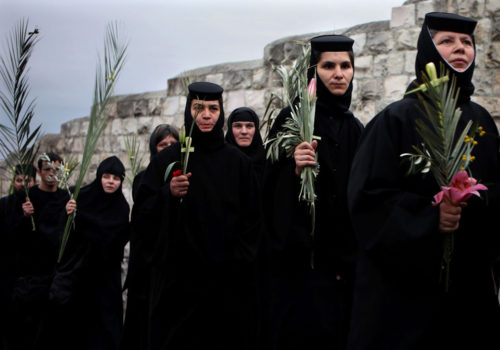This is an invitation to embark on a magical mystical tour, a glimpse into a secret world through a labyrinth of chapels and altars, a kaleidoscope of colours and textures, a unique fusion of people and cultures. Tucked away, deep in the maze of winding, narrow streets in Jerusalem’s Old City, stands the Church of the Holy Sepulchre, one of the most famous but least explored religious sites in the world. The church was built on the spot where Jesus is believed to have been crucified, buried and resurrected, the very place where Christianity was born. The church of the Holy Sepulchre was constructed by the Byzantines and rebuilt by the Crusaders. It remains the most popular destination for countless Christian pilgrims from across the globe.
Clergy and believers chant words of prayer in a mix of languages last heard in the Tower of Babel. Bishops conduct exotic rituals in biblical Aramaic as other ancient tongues echo through the darkness of Christianity’s most sacred shrine. Mysterious monks circle the tomb swinging aromatic incense, as rays of magical light break through. It is an enigmatic mix of rituals belonging to some of the earliest Christian sects, still conducted today. It is perhaps the only place in the world where processions and masses converge under the same roof and a diverse crowd of worshippers recites prayers side by side. Over the past seventeen centuries people from all over the world have been drawn to the ancient, sacred stones as if by a magnetic power: pilgrims in ecstasy, light in their eyes, praying with the ultimate expression of devotion, not leaving before they have touched, kissed, prayed and knelt before every sacred altar. Outside, transfixed worshippers carry wooden crosses as they retrace the last steps of Jesus along the winding path of the Via Dolorosa that comes to an end at the Holy Sepulchre.
Jerusalem is not just the focus of international political attention; it is also the focus of the three great monotheistic religions. Ancient texts and maps describe Jerusalem as «the centre of the world», the world’s point of beginning. Halfway between east and west, Jerusalem has not become a melting pot, but remains a mosaic in which cultures and religions mix yet never combine, each remaining as distinct as possible from the other. The Christians are an ever-dwindling minority in the Middle East and the different streams share a common concern about their future in the region. But instead of being united by belief inside the Church, they are often divided, each fighting a constant battle to preserve its ethno-religious identity. Centuries-long struggle over power and territory left the church divided between six denominations of Christianity. The fierce devotion with which each faction guards its turf is legendary. Three main sects – Roman Catholic, Greek Orthodox and Armenian – have principal custody of the church under an edict issued in 1852 by the ruling Ottoman Sultan, known today as the Status Quo agreement. The additional denominations, Coptic (Egyptian), Syrian Orthodox and Ethiopian, are given space and rights within the church. The Sultan’s Status Quo froze time. Centuries of unchanged religious traditions and multi-ethnic domination combine into a unique and extraordinary collage of people and faith, not seen anywhere else.
Gali Tibbon
FESTIVAL
PhotoMed 2013
Echoes of Christian Jerusalem
From May 23th, to June 16th 2013
ChapelleNotre Dame de Pitié
83110 Sanary-sur-Mer
France
















